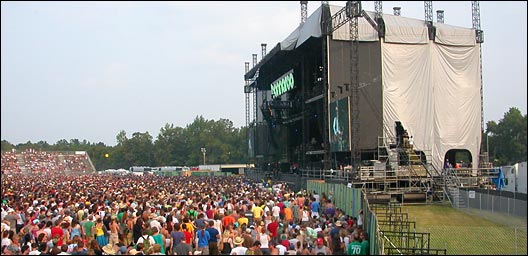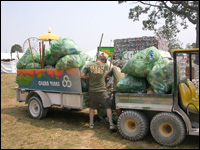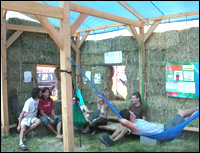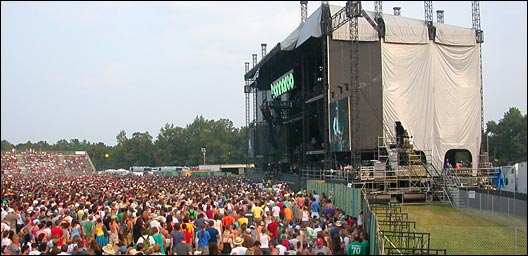
Two’s company, 80,000’s a crowd.
Photos: Sarah van Schagen.
For most of the year, this 700-acre farm in Manchester, Tenn., provides open, grassy pasture for a herd of cows. But for a short time each summer, the idyllic setting is taken over by a different kind of herd: the tens of thousands of fans who descend for the Bonnaroo Music & Arts Festival. The now-legendary event features long-haired musician-types, massive stages, sprawling campgrounds, and vendors hawking all manner of food and crafts. As Thom Yorke — the frontman for this year’s headliner, Radiohead — put it to the writhing masses waving glow-sticks under a star-speckled sky last week, “Now this is what we call a festival.”
But with some 80,000 people camping out for the four-day, 24-hour jam-band showcase, whose other featured acts included Tom Petty, Phil Lesh, and Beck, Bonnaroo is much more than a festival. In the words of psych-folk singer-songwriter Devendra Banhart, “It’s an opportunity to live in a temporary village centered around music, expression, awareness, consciousness — all the goodies!” The festival literally becomes a community — complete with residential areas, trailers with running water, port-o-potties, wi-fi and cell-phone service, security officials, and medical facilities — and deals with many of the issues a small city might. Which is why organizers made a conscious effort to reduce its environmental footprint this year, and have even grander plans for the future.
So how do you convince throngs of half-naked, half-baked music lovers to go green? By showing the way. To reduce global-warming impacts, biodiesel generators powered all of the non-music stages, as well as the spotlights used at night and some of the golf carts zipping along the dust-covered “roads” between camping areas. ‘Rooers were given the opportunity to purchase Cool Tags to offset their travel. In an area of the grounds known as “Planet Roo,” a solar-powered stage was flanked by vendors selling organic foods and natural products, and booths manned by nonprofits ranging from national groups like the Natural Resources Defense Council and the World Resources Institute to advocates working on local issues like mountaintop-removal mining.

Clean Vibes: the quicker picker-upper.
Then there was the eco-army dealing with waste: some 600 tons of it. Clean Vibes — the official “pick up the mess organization,” according to head picker-upper Anna Borofsky — set up 2,000 trash barrels and 2,000 recycling bins throughout the grounds, carting filled bags to sorting facilities and composting areas. By recycling plastic bottles and aluminum cans, Bonnaroo officials hoped to divert more than 60 percent of the event’s waste from landfills. An organization called WastAway will also contribute, by melting down and compacting 250 tons of the non-recyclable, non-biodegradable garbage into “fluff” that can be used for park benches and construction.
“These festivals are a kind of microcosm of the real world,” Borofsky said, adding that the Bonnaroo community serves as an example of what’s possible. “By showing people that [this community can run] in a sustainable way, then we can apply that to the big picture.”
Spanning all generations, Bonnaroo’s “citizens” ranged from hippie to hipster, but Borofsky says she’s noticed more of a “hippie-crite” presence at many of the large music festivals. “[We’re trying to] teach people that if we don’t respect the land that we’re allowed to have these amazing gatherings on, then we’re not going to be able to have these amazing gatherings anymore.”
Giving ‘Em Something to Talk About
On Saturday, the members of “high-altitude bluegrass” quintet Hot Buttered Rum String Band spent an hour-plus on the Solar Stage playing a few of their politically charged songs — including “Well-Oiled Machine” and “Guns or Butter” — and explaining the finer points of biodiesel filtration to an engaged audience. After realizing they’d be touring the country without much money, the band explained, they decided there was an “obvious solution”: using waste veggie oil in their bus. They took a few classes at a local college to learn how to make it work, then hit the road.
They weren’t the only artists who practiced what they preached. The next day, Bonnie Raitt, long a fighter for environmental justice, forest protection, and an end to nuclear power, also took to the Solar Stage for a one-on-one interview with Rock the Earth founder Marc Ross. “I’m a musician,” Raitt said, “but I live [on this planet] and breathe this air, and I eat this food, and I don’t wanna contribute in my lifestyle to not making things better.” She named sustainability “the issue of our time,” and offered hope to the large crowd of listeners. “The seeds of change are really already creating a groundswell of movement for protecting the environment and switching to a different way of looking at our place in the world and on our planet,” she said.
Conversations with other artists proved that many of them also had green issues on the brain. Disco Biscuits guitarist Jon Gutwillig spends an extra $4 a month to purchase wind power, and said he was shocked by the small percentage of people in his home state choosing to do the same. Brendan Bayliss of Umphrey’s McGee called for less talk and more action when it comes to wanting change. And Daily Show comedian Lewis Black? Well, he admitted that despite mentioning green issues in his act, he’s “more worried about the laugh than the environment.” In true Lewis Black style, he also claimed he’s on tour so much that he’s “never anywhere long enough to bother any environment.”
A bit more serious about his impact, hip-hopper Lyrics Born said he’s always “thinking of new ways to do more with less” — including limiting the items on his backstage request list to those he’ll really use. “Knowing what I know now, I don’t really want to leave anything on the table,” he said. “It was only there for my ego to begin with.”
“It’s been an educational experience for me,” echoed Ted Pecchio of jam-rockers The Codetalkers. “I’ve learned more today [about environmental awareness] than I’ve learned probably in my life, just meeting people who are really, truly informed.”
During a panel discussion with Borofsky, two Hot Buttered Rum-mates, and Liz Berlin of Rusted Root, Andy Bernstein of get-out-the-vote group HeadCount pointed out the importance of having so many influential artists speaking out about social issues. “If we have something like this [panel] where we give these guys a platform to share what they’re doing,” he said, “we have so much of an opportunity to change so many people.”
“It’s important to realize what our part in the environmental movement is,” said Hot Buttered Rum guitarist/vocalist Nat Keefe. “We play music, we’re artists, but we bring people together, and [create] this opportunity to exchange ideas.”

Like peeps in a green pod.
Far from the stage, lounging on a hammock in a timber-framed, straw-bale structure known as the “green pod,” Bonnaroo consultant Zach Carson confirmed the importance of connecting artists, issues, and audiences. Situated near Camp Ferris Bueller and Camp Sloane Peterson, his domain was one of many color-coded pods for campers needing maps, medical attention, or munchies. But Carson’s area offered much more — including information from a number of environmental groups, workshops about green building, and even a “river” made from empty blue water bottles.
Carson, of Change of Atmosphere, said he thought that his pod was a “great first step.” But he added that he has big plans for future ‘Roos, ranging from collecting vendors’ waste oil to creating community kitchens with bike-powered generators. “It’s important just to be conscious of the different ways that are available to change the way we all live on this planet,” he said. “And festivals provide a wonderful opportunity to introduce those ideas.”
Check out our behind-the-scenes look at covering Bonnaroo.


